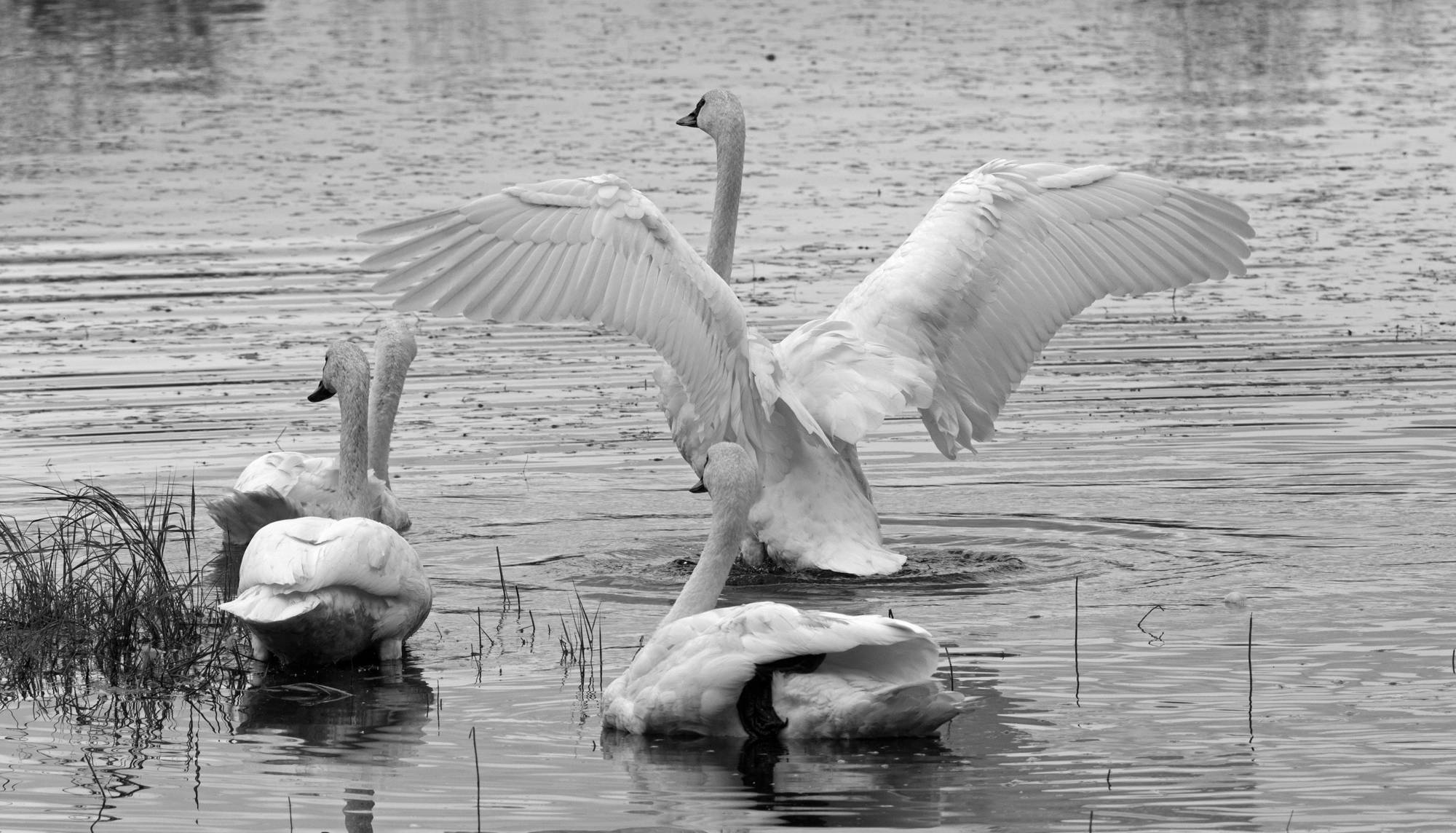One of the great treats of fall is finding a group of these huge white birds hanging out on a pond somewhere, maybe resting, preening, feeding a bit, or just gliding elegantly from here to there. The swans I see here are usually trumpeter swans. They really are big: the wingspan is about six and a half feet, in the same size range as that of an eagle. But they weigh about 22 to 26 pounds, more than twice the typical weight of an eagle.
Their feet are correspondingly large. We are used to seeing the webbed footprints of ducks and gulls, but several duck footprints could fit into a single swan footprint. Years ago, I stood with a couple of friends on the snowy ice of the Old River Channel, marveling at the footprints of swans, which are six or seven inches long. Given the size of the bird, perhaps this is not disproportionate.
Trumpeter swans that nest in Alaska generally spend the winter somewhere along the coast of Southeast Alaska, British Columbia, or Washington. They could be found anywhere there is open water and food, but some spots are particularly attractive, such as the Skagit Valley and waters near Vancouver Island.
Swans are primarily herbivorous, eating aquatic vegetation, but they also ingest invertebrates along with leaves and tubers, and occasionally eat fish and fish eggs.
Trumpeters are very territorial when nesting, defending their space not only from other swans but also from various other waterfowl. They are monogamous, sometimes just for one season, sometimes for the long-term. Both male and female build their nest (mostly the female), and she may start to lay her eggs before the nest is quite complete. The usual clutch size is four to six eggs, laid almost two days apart. Incubation, mostly by the female, starts before the clutch is complete, so the eggs do not hatch synchronously. Rather than incubating their eggs with the warm skin of a featherless brood patch on the belly, as most birds do, trumpeters cover the eggs with their huge feet, which have a good supply of blood vessels that carry warm blood.
Incubation takes four to five weeks. When the eggs hatch, the chicks (called cygnets) are brooded for a day or two; after that, the adults may brood them at night and during bad weather. When the cygnets leave the nest, they follow their parents for three to four months, learning how to find food. The adults actually help the very young cygnets by treading the mud to stir up vegetation and invertebrates. The average brood size in Alaska is reported to be about three cygnets. Sometimes broods of different parents join up, possibly as a way to increase access to food (more stirring) or to decrease the risk of predation (more eyes looking).
They are slow to reach maturity, typically taking four to seven years before they breed. In any one year, however, only a fraction of the population is reported to breed.
Formerly widespread and abundant, trumpeter swans are now much reduced in number, because of habitat loss and overhunting. Breeding populations are scattered across central Alaska to the Midwest, the Pacific Northwest, and western Canada. Some of these remnant populations are still at risk from loss of good habitat and lead poisoning (from lead shot and fishing weights). This species is now protected—it is illegal to hunt trumpeters (as of 2017), and restoration efforts have led to a moderate increase in numbers.
The tundra swan, also called the whistling swan, is considerably smaller, weighing roughly 13 pounds. It breeds in tundra ponds across the Arctic of North America and Eurasia. On the nesting grounds, tundra swans are territorial and monogamous; the pair bond is commonly maintained year-round. They mature at age three to five years. Both parents tend the three to five eggs for about a month, and attend the growing cygnets. Our populations migrate south to winter mostly on the east and west coasts; those from western Alaska stay in the west, while those from the north go to the east coast. Family groups often migrate together.
It is legal to hunt tundra swans, but not trumpeters, so it is important to be able to distinguish the two species. One criterion is obviously size: tundras are roughly two-thirds the size of trumpeters, by weight. Their wingspan is about five and a half feet, less than that of a trumpeter. The shape of the forehead of tundras is steeper than on trumpeters, which have a more sloping profile. Viewed face-on, the border of the forehead where it meets the bill is either rounded (tundra) or v-shaped (trumpeter). And tundra swans usually have a yellow patch at the base of the bill near the eye, a patch that trumpeters lack.
The hunting pressure on tundra swans is high, and only some of it is within the regulations. Many more are killed by hunting outside of the regulations, including Native subsistence, than by the regulated hunts. Undoubtedly, some trumpeters are killed illegally, sometimes by mistake, sometimes clandestinely.
• Mary F. Willson is a retired professor of ecology. “On The Trails” appears every Friday. Her essays can be found online at onthetrailsjuneau.wordpress.com.

